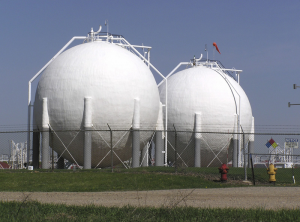 Natural gas fell to the lowest since July, erasing previous daily gains, after the Energy Information Administration reported a larger-than-expected build in US natural gas stockpiles for the week ended October 10th. Overall mild weather with no signs of widespread freezes throughout October helped sustain the bearish tone.
Natural gas fell to the lowest since July, erasing previous daily gains, after the Energy Information Administration reported a larger-than-expected build in US natural gas stockpiles for the week ended October 10th. Overall mild weather with no signs of widespread freezes throughout October helped sustain the bearish tone.
November natural gas traded 0.87% lower at $3.767 per million British thermal units at 14:38 GMT on the New York Mercantile Exchange, having shifted in a daily range of $3.834-$3.748. The power-station fuel fell for a second day on Wednesday and settled 0.42% lower at $3.800, the lowest close since September 5th.
The Energy Information Administration reported on Thursday that US natural gas inventories rose by 94 billion cubic feet (bcf) in the seven days through October 10th, exceeding analysts projections for a build in the range of 89-92 bcf and the five-year average gain of 78 billion.
Total gas held in US storage stood at 3.299 trillion cubic feet, narrowing the deficit to the five-year average to 9.9%, down from 10.5% a week earlier, and also shrinking the gap to last years 3.643 trillion to 9.4%, from 10.1% during the preceding week.
The East region received a net injection of 49 bcf to 1.825 trillion, 7.6% below the average, while inventories in the West region rose by 10 bcf, narrowing its 5-year-average deficit to 7.2%. The Producing region received a build of 35 billion cubic feet to 1.000 trillion and stood 14.7% below the average.
The EIA said in its Short-Term Energy Outlook dated October 7th that inventories may rise to 3.532 trillion cubic feet by the end of the month, the lowest for this time of the year in six years.
US weather
According to NatGasWeather.com, natural gas demand over the next seven days will be moderate compared to normal. A weather system will trek today across the eastern parts of the country, carrying showers, thunderstorms and below-average temperatures. Additional reinforcing cool blasts will push overnight lows into the 40s and 30s on Friday and during the weekend, with localized freezes, inducing modest heating demand.
However, those weather systems will not be significant enough to bring widespread and consistent freezing temperatures, leaving the markets supported, but also unable to advance much.
The far southern US and Plains will remain warmer than usual throughout the week with highs in the upper 80s, stoking late season cooling demand for the energy source.
Next week, numerous weather systems with showers, thunderstorms and slightly lower-than-usual temperatures will track across the Midwest and Northeast, and will also push deep into the Southeast. The southern US will continue to gradually cool, with the until-recently widespread highs in the 80s and 90s becoming rarer, easing the need for cooling.
Both the southern and western parts of the country will remain near or little above average, shifting the focus away from the light cooling demand in the South to heating in the North, where widespread freezes are expected to become present in November. Colder weather might be expected over the northern US at the end of October and early November, NatGasWeather.com said, but patterns are not clear enough yet.





